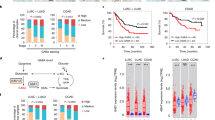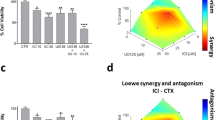Abstract
Here, we evaluated the therapeutic potential of antibodies (Abs) targeting cholinergic receptor nicotinic beta 2 subunit (CHRNB2) in gastric cancer. To investigate the effects of these Abs on malignant phenotypes in vitro and in mouse xenograft models, we generated gene knockouts through genome editing, performed RNA interference-mediated knockdown of gene expression, and ectopically expressed CHRNB2 in gastric cancer cells. The effects of anti-CHRNB2 Abs on the proliferation of cancer cells were evaluated both in vitro and in vivo. We determined the effects of Chrnb2 deficiency on mice and the clinical significance of CHRNB2 expression in gastric cancer clinical specimens. Knockdown of CHRNB2 attenuated gastric cancer cell proliferation, whereas forced overexpression of CHRNB2 increased cell proliferation. Knockout of CHRNB2 significantly influenced cell survival and functions associated with metastasis. The effects of polyclonal Abs targeting the C- and N-termini of CHRNB2 guided the development of anti-CHRNB2 monoclonal Abs that inhibited the growth of gastric cancer cells in vitro and in vivo. Pathway analysis revealed that CHRNB2 interfered with signaling through the PI3K-AKT and JAK-STAT pathways. Chrnb2-deficient mice exhibited normal reproduction, organ functions, and motor functions. CHRNB2 regulates multiple oncological phenotypes associated with metastasis, and blockade of CHRNB2 expression using specific Abs shows promise for controlling metastasis in gastric cancer.
This is a preview of subscription content, access via your institution
Access options
Subscribe to this journal
Receive 50 print issues and online access
$259.00 per year
only $5.18 per issue
Buy this article
- Purchase on Springer Link
- Instant access to full article PDF
Prices may be subject to local taxes which are calculated during checkout







Similar content being viewed by others
References
Thrift AP, El-Serag HB. Burden of gastric cancer. Clin Gastroenterol Hepatol 2020;18:534–42.
Smyth EC, Nilsson M, Grabsch HI, van Grieken NC, Lordick F. Gastric cancer. Lancet. 2020;396:635–48.
Shen L, Shan YS, Hu HM, Price TJ, Sirohi B, Yeh KH, et al. Management of gastric cancer in Asia: resource-stratified guidelines. Lancet Oncol. 2013;14:e535–47.
Zahavi D, Weiner L. Monoclonal antibodies in cancer therapy. Antibodies. 2020;9:34.
Zhao R, Xiao Q, Li M, Ren W, Xia C, Liu X, et al. Rational design of peptides for identification of linear epitopes and generation of neutralizing monoclonal antibodies against DKK2 for cancer therapy. Antib Ther. 2020;3:63–70.
Muro K, Chung HC, Shankaran V, Geva R, Catenacci D, Gupta S, et al. Pembrolizumab for patients with PD-L1-positive advanced gastric cancer (KEYNOTE-012): a multicentre, open-label, phase 1b trial. Lancet Oncol. 2016;17:717–26.
Shitara K, Ozguroglu M, Bang YJ, Di Bartolomeo M, Mandala M, Ryu MH, et al. Pembrolizumab versus paclitaxel for previously treated, advanced gastric or gastro-oesophageal junction cancer (KEYNOTE-061): a randomised, open-label, controlled, phase 3 trial. Lancet. 2018;392:123–33.
Bang YJ, Van Cutsem E, Feyereislova A, Chung HC, Shen L, Sawaki A, et al. Trastuzumab in combination with chemotherapy versus chemotherapy alone for treatment of HER2-positive advanced gastric or gastro-oesophageal junction cancer (ToGA): a phase 3, open-label, randomised controlled trial. Lancet. 2010;376:687–97.
Kanda M, Suh YS, Park DJ, Tanaka C, Ahn SH, Kong SH, et al. Serum levels of ANOS1 serve as a diagnostic biomarker of gastric cancer: a prospective multicenter observational study. Gastric Cancer. 2020;23:203–11.
Wadhwa R, Song S, Lee JS, Yao Y, Wei Q, Ajani JA. Gastric cancer-molecular and clinical dimensions. Nat Rev Clin Oncol. 2013;10:643–55.
Razzak M. Genetics: new molecular classification of gastric adenocarcinoma proposed by The Cancer Genome Atlas. Nat Rev Clin Oncol. 2014;11:499.
Velazquez EJ, Brindley TD, Shrestha G, Bitter EE, Cress JD, Townsend MH, et al. Novel monoclonal antibodies against thymidine kinase 1 and their potential use for the immunotargeting of lung, breast and colon cancer cells. Cancer Cell Int. 2020;20:127.
Chen Z, Wang L, Wang C, Chen Q, Zhai Q, Guo Y, et al. Mutational analysis of CHRNB2, CHRNA2 and CHRNA4 genes in Chinese population with autosomal dominant nocturnal frontal lobe epilepsy. Int J Clin Exp Med. 2015;8:9063–70.
Pedersen JE, Bergqvist CA, Larhammar D. Evolution of vertebrate nicotinic acetylcholine receptors. BMC Evol Biol. 2019;19:38.
Cheng WL, Chen KY, Lee KY, Feng PH, Wu SM. Nicotinic-nAChR signaling mediates drug resistance in lung cancer. J Cancer. 2020;11:1125–40.
Ehringer MA, Clegg HV, Collins AC, Corley RP, Crowley T, Hewitt JK, et al. Association of the neuronal nicotinic receptor beta2 subunit gene (CHRNB2) with subjective responses to alcohol and nicotine. Am J Med Genet B Neuropsychiatr Genet. 2007;144b:596–604.
Perkins KA, Lerman C, Mercincavage M, Fonte CA, Briski JL. Nicotinic acetylcholine receptor beta2 subunit (CHRNB2) gene and short-term ability to quit smoking in response to nicotine patch. Cancer Epidemiol Biomark Prev. 2009;18:2608–12.
Calcagno DQ, Gigek CO, Chen ES, Burbano RR, Smith Mde A. DNA and histone methylation in gastric carcinogenesis. World J Gastroenterol. 2013;19:1182–92.
Janjigian YY, Kelsen DP. Genomic dysregulation in gastric tumors. J Surg Oncol. 2013;107:237–42.
Network. CGAR. Comprehensive molecular characterization of gastric adenocarcinoma. Nature. 2014;513:202–9.
Schaal C, Chellappan SP. Nicotine-mediated cell proliferation and tumor progression in smoking-related cancers. Mol Cancer Res. 2014;12:14–23.
Ibrahim SM, Al-Shorbagy MY, Abdallah DM, El-Abhar HS. Activation of α7 nicotinic acetylcholine receptor ameliorates zymosan-induced acute kidney injury in BALB/c mice. Sci Rep. 2018;8:16814.
Dasgupta P, Rizwani W, Pillai S, Kinkade R, Kovacs M, Rastogi S, et al. Nicotine induces cell proliferation, invasion and epithelial-mesenchymal transition in a variety of human cancer cell lines. Int J Cancer. 2009;124:36–45.
Zhang Z, Liu X, Huang R, Liu X, Liang Z, Liu T. Upregulation of nucleoprotein AHNAK is associated with poor outcome of pancreatic ductal adenocarcinoma prognosis via mediating epithelial-mesenchymal transition. J Cancer. 2019;10:3860–70.
Umeda S, Kanda M, Miwa T, Tanaka H, Tanaka C, Kobayashi D, et al. Fraser extracellular matrix complex subunit 1 promotes liver metastasis of gastric cancer. Int J Cancer. 2020;146:2865–76.
Vandamme N, Denecker G, Bruneel K, Blancke G, Akay Ö, Taminau J, et al. The EMT transcription factor ZEB2 promotes proliferation of primary and metastatic melanoma while suppressing an invasive, mesenchymal-like phenotype. Cancer Res. 2020;80:2983–95.
Kanda M, Kasahara Y, Shimizu D, Miwa T, Umeda S, Sawaki K, et al. Amido-bridged nucleic acid-modified antisense oligonucleotides targeting SYT13 to treat peritoneal metastasis of gastric cancer. Mol Ther Nucleic Acids. 2020;22:791–802.
Gao J, Zhu Y, Nilsson M, Sundfeldt K. TGF-beta isoforms induce EMT independent migration of ovarian cancer cells. Cancer Cell Int. 2014;14:72.
Lamouille S, Xu J, Derynck R. Molecular mechanisms of epithelial-mesenchymal transition. Nat Rev Mol Cell Biol. 2014;15:178–96.
Ambrosi P, Becchetti A. Targeting neuronal nicotinic receptors in cancer: new ligands and potential side-effects. Recent Pat Anticancer Drug Discov. 2013;8:38–52.
Chen J, Cheuk IWY, Shin VY, Kwong A. Acetylcholine receptors: key players in cancer development. Surg Oncol. 2019;31:46–53.
Kanda M, Tanaka H, Shimizu D, Miwa T, Umeda S, Tanaka C, et al. SYT7 acts as a driver of hepatic metastasis formation of gastric cancer cells. Oncogene. 2018;37:5355–66.
Szasz AM, Lanczky A, Nagy A, Forster S, Hark K, Green JE, et al. Cross-validation of survival associated biomarkers in gastric cancer using transcriptomic data of 1,065 patients. Oncotarget. 2016;7:49322–33.
Kanda M, Shimizu D, Tanaka H, Tanaka C, Kobayashi D, Hayashi M, et al. Significance of SYT8 for the detection, prediction, and treatment of peritoneal metastasis from gastric cancer. Ann Surg. 2018;267:495–503.
Kanda M, Shimizu D, Fujii T, Sueoka S, Tanaka Y, Ezaka K, et al. Function and diagnostic value of Anosmin-1 in gastric cancer progression. Int J Cancer. 2016;138:721–30.
Miwa T, Kanda M, Shimizu D, Umeda S, Sawaki K, Tanaka H, et al. Hepatic metastasis of gastric cancer is associated with enhanced expression of ethanolamine kinase 2 via the p53-Bcl-2 intrinsic apoptosis pathway. Br J Cancer. 2021;124:1449–60.
Kanda M, Shimizu D, Sawaki K, Nakamura S, Umeda S, Miwa T, et al. Therapeutic monoclonal antibody targeting of neuronal pentraxin receptor to control metastasis in gastric cancer. Mol Cancer. 2020;19:131.
Wang H, Yang H, Shivalila CS, Dawlaty MM, Cheng AW, Zhang F, et al. One-step generation of mice carrying mutations in multiple genes by CRISPR/Cas-mediated genome engineering. Cell. 2013;153:910–8.
Katsuno M, Adachi H, Kume A, Li M, Nakagomi Y, Niwa H, et al. Testosterone reduction prevents phenotypic expression in a transgenic mouse model of spinal and bulbar muscular atrophy. Neuron. 2002;35:843–54.
Acknowledgements
We thank Edanz Group (https://en-author-services.edanz.com/ac) and the SPRINGER NATURE English Language Editing service (https://authorservices.springernature.com/language-editing/) for editing a draft of this manuscript. This work was supported by a Grant-in-Aid for Scientific Research (B, 20H03750), the Japan Agency for Medical Research and Development (17lm0203005j0001, 2017); the Center for Advanced Medicine and Clinical Research at Nagoya University (2018); a grant (2018) from the Japan Research Foundation for Clinical Pharmacology, Foundation for Promotion of Cancer Research, Kobayashi Foundation for Cancer Research; and the Mochida Memorial Foundation for Medical and Pharmaceutical Research.
Author information
Authors and Affiliations
Contributions
MK: data acquisition and analysis, interpretation of data, and drafting the manuscript. SN, KS, SU, TM, HT, and DS: acquisition and interpretation of data, manuscript revision. YI, NH, MH, CT, GN, and YI: material support, generation of data. YK and MK: study concept and design, study supervision, interpretation of data, and revision of the manuscript. MK had full access to all data and takes full responsibility for the veracity of the data and statistical analysis.
Corresponding author
Ethics declarations
Competing interests
The authors declare no competing interests.
Additional information
Publisher’s note Springer Nature remains neutral with regard to jurisdictional claims in published maps and institutional affiliations.
Rights and permissions
About this article
Cite this article
Kanda, M., Shimizu, D., Nakamura, S. et al. Blockade of CHRNB2 signaling with a therapeutic monoclonal antibody attenuates the aggressiveness of gastric cancer cells. Oncogene 40, 5495–5504 (2021). https://doi.org/10.1038/s41388-021-01945-9
Received:
Revised:
Accepted:
Published:
Issue Date:
DOI: https://doi.org/10.1038/s41388-021-01945-9
This article is cited by
-
Circadian clock-related genome-wide mendelian randomization identifies putatively genes for ulcerative colitis and its comorbidity
BMC Genomics (2024)
-
Killer cell lectin-like receptor G2 facilitates aggressive phenotypes of gastric cancer cells via dual activation of the ERK1/2 and JAK/STAT pathways
Gastric Cancer (2024)
-
Identification of stromal cell-derived factor 4 as a liquid biopsy-based diagnostic marker in solid cancers
Scientific Reports (2023)
-
CHRNB2 represses pancreatic cancer migration and invasion via inhibiting β-catenin pathway
Cancer Cell International (2022)



